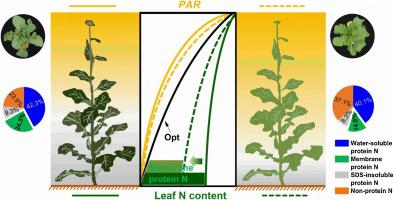当前位置:
X-MOL 学术
›
Field Crops Res.
›
论文详情
Our official English website, www.x-mol.net, welcomes your
feedback! (Note: you will need to create a separate account there.)
Canopy light and nitrogen distribution are closely related to nitrogen allocation within leaves in Brassica napus L.
Field Crops Research ( IF 5.6 ) Pub Date : 2020-11-01 , DOI: 10.1016/j.fcr.2020.107958 Tao Liu , Yonghui Pan , Zhifeng Lu , Tao Ren , Jianwei Lu
Field Crops Research ( IF 5.6 ) Pub Date : 2020-11-01 , DOI: 10.1016/j.fcr.2020.107958 Tao Liu , Yonghui Pan , Zhifeng Lu , Tao Ren , Jianwei Lu

|
Abstract Optimizing canopy nitrogen (N) distribution to match the light gradient is crucial for maximizing canopy carbon gain and improving N utilization efficiency (NUtE) in crops. Light interception and utilization depend not only on canopy N distribution but also on leaf N allocation in the thylakoid light-harvesting proteins (membrane proteins) and Rubisco (water-soluble proteins). However, the distribution of different forms of N in the canopy and its relationship with canopy light and N distribution have not yet been clarified. In this study, two Brassica napus L. cultivars, Zhongyouza R5 (R5) and Huayouza No. 9 (H9), were grown under four N levels in a two-year field experiment to provide some insight into the coordination between light and N distribution in the canopy. The results showed that R5 absorbed the equivalent N and produced higher shoot biomass than H9, thereby improving the NUtE. Compared with H9, R5 had a lower light extinction coefficient (KL) and a higher N extinction coefficient (KN), thereby its light and N coordination parameter (KN/KL) being greater in both growing seasons. The fraction of SDS (sodium dodecyl sulfate; a detergent) soluble proteins associated with membrane proteins in R5 was 40.4 % lower than H9. Through a d-separation method of path analysis, KL and KN could be simultaneously improved by reducing SDS-soluble proteins N or increasing the extinction coefficient of water-soluble proteins N. This suggests that optimizing leaf N allocation could improve canopy light and N distribution, thereby enhancing canopy carbon gain and NUtE.
中文翻译:

甘蓝型油菜的冠层光和氮分布与叶片内的氮分配密切相关。
摘要 优化冠层氮 (N) 分布以匹配光照梯度对于最大化冠层碳增益和提高作物的氮利用效率 (NUtE) 至关重要。光的拦截和利用不仅取决于冠层氮的分布,而且还取决于类囊体光捕获蛋白(膜蛋白)和 Rubisco(水溶性蛋白)中的叶片氮分配。然而,冠层中不同形态氮的分布及其与冠层光照和氮分布的关系尚未阐明。在这项研究中,在为期两年的田间试验中,两种油菜品种中油杂 R5 (R5) 和花油杂 9 号 (H9) 在四个 N 水平下生长,以提供对光和 N 分布之间协调的一些了解在天篷里。结果表明,与H9相比,R5吸收了等量的N并产生了更高的地上部生物量,从而提高了NUtE。与H9相比,R5具有较低的消光系数(KL)和较高的氮消光系数(KN),因此其光氮协调参数(KN/KL)在两个生长季都较大。R5 中与膜蛋白相关的 SDS(十二烷基硫酸钠;一种去污剂)可溶性蛋白的分数比 H9 低 40.4%。通过路径分析的d-separation方法,可以通过降低SDS可溶性蛋白质N或增加水溶性蛋白质N的消光系数来同时改善KL和KN。 这表明优化叶片N分配可以改善冠层光和N分布,从而提高冠层碳增益和 NUtE。与H9相比,R5具有较低的消光系数(KL)和较高的氮消光系数(KN),因此其光氮协调参数(KN/KL)在两个生长季都较大。R5 中与膜蛋白相关的 SDS(十二烷基硫酸钠;一种去污剂)可溶性蛋白的分数比 H9 低 40.4%。通过路径分析的d-separation方法,可以通过降低SDS可溶性蛋白质N或增加水溶性蛋白质N的消光系数来同时改善KL和KN。 这表明优化叶片N分配可以改善冠层光和N分布,从而提高冠层碳增益和 NUtE。与H9相比,R5具有较低的消光系数(KL)和较高的氮消光系数(KN),因此其光氮协调参数(KN/KL)在两个生长季都较大。R5 中与膜蛋白相关的 SDS(十二烷基硫酸钠;一种去污剂)可溶性蛋白的分数比 H9 低 40.4%。通过路径分析的d-separation方法,可以通过降低SDS可溶性蛋白质N或增加水溶性蛋白质N的消光系数来同时改善KL和KN。 这表明优化叶片N分配可以改善冠层光和N分布,从而提高冠层碳增益和 NUtE。因此它的光和氮协调参数(KN/KL)在两个生长季节都更大。R5 中与膜蛋白相关的 SDS(十二烷基硫酸钠;一种去污剂)可溶性蛋白的分数比 H9 低 40.4%。通过路径分析的d-separation方法,可以通过降低SDS可溶性蛋白质N或增加水溶性蛋白质N的消光系数来同时改善KL和KN。 这表明优化叶片N分配可以改善冠层光和N分布,从而提高冠层碳增益和 NUtE。因此它的光和氮协调参数(KN/KL)在两个生长季节都更大。R5 中与膜蛋白相关的 SDS(十二烷基硫酸钠;一种去污剂)可溶性蛋白的分数比 H9 低 40.4%。通过路径分析的d-separation方法,可以通过降低SDS可溶性蛋白质N或增加水溶性蛋白质N的消光系数来同时改善KL和KN。 这表明优化叶片N分配可以改善冠层光和N分布,从而提高冠层碳增益和 NUtE。
更新日期:2020-11-01
中文翻译:

甘蓝型油菜的冠层光和氮分布与叶片内的氮分配密切相关。
摘要 优化冠层氮 (N) 分布以匹配光照梯度对于最大化冠层碳增益和提高作物的氮利用效率 (NUtE) 至关重要。光的拦截和利用不仅取决于冠层氮的分布,而且还取决于类囊体光捕获蛋白(膜蛋白)和 Rubisco(水溶性蛋白)中的叶片氮分配。然而,冠层中不同形态氮的分布及其与冠层光照和氮分布的关系尚未阐明。在这项研究中,在为期两年的田间试验中,两种油菜品种中油杂 R5 (R5) 和花油杂 9 号 (H9) 在四个 N 水平下生长,以提供对光和 N 分布之间协调的一些了解在天篷里。结果表明,与H9相比,R5吸收了等量的N并产生了更高的地上部生物量,从而提高了NUtE。与H9相比,R5具有较低的消光系数(KL)和较高的氮消光系数(KN),因此其光氮协调参数(KN/KL)在两个生长季都较大。R5 中与膜蛋白相关的 SDS(十二烷基硫酸钠;一种去污剂)可溶性蛋白的分数比 H9 低 40.4%。通过路径分析的d-separation方法,可以通过降低SDS可溶性蛋白质N或增加水溶性蛋白质N的消光系数来同时改善KL和KN。 这表明优化叶片N分配可以改善冠层光和N分布,从而提高冠层碳增益和 NUtE。与H9相比,R5具有较低的消光系数(KL)和较高的氮消光系数(KN),因此其光氮协调参数(KN/KL)在两个生长季都较大。R5 中与膜蛋白相关的 SDS(十二烷基硫酸钠;一种去污剂)可溶性蛋白的分数比 H9 低 40.4%。通过路径分析的d-separation方法,可以通过降低SDS可溶性蛋白质N或增加水溶性蛋白质N的消光系数来同时改善KL和KN。 这表明优化叶片N分配可以改善冠层光和N分布,从而提高冠层碳增益和 NUtE。与H9相比,R5具有较低的消光系数(KL)和较高的氮消光系数(KN),因此其光氮协调参数(KN/KL)在两个生长季都较大。R5 中与膜蛋白相关的 SDS(十二烷基硫酸钠;一种去污剂)可溶性蛋白的分数比 H9 低 40.4%。通过路径分析的d-separation方法,可以通过降低SDS可溶性蛋白质N或增加水溶性蛋白质N的消光系数来同时改善KL和KN。 这表明优化叶片N分配可以改善冠层光和N分布,从而提高冠层碳增益和 NUtE。因此它的光和氮协调参数(KN/KL)在两个生长季节都更大。R5 中与膜蛋白相关的 SDS(十二烷基硫酸钠;一种去污剂)可溶性蛋白的分数比 H9 低 40.4%。通过路径分析的d-separation方法,可以通过降低SDS可溶性蛋白质N或增加水溶性蛋白质N的消光系数来同时改善KL和KN。 这表明优化叶片N分配可以改善冠层光和N分布,从而提高冠层碳增益和 NUtE。因此它的光和氮协调参数(KN/KL)在两个生长季节都更大。R5 中与膜蛋白相关的 SDS(十二烷基硫酸钠;一种去污剂)可溶性蛋白的分数比 H9 低 40.4%。通过路径分析的d-separation方法,可以通过降低SDS可溶性蛋白质N或增加水溶性蛋白质N的消光系数来同时改善KL和KN。 这表明优化叶片N分配可以改善冠层光和N分布,从而提高冠层碳增益和 NUtE。











































 京公网安备 11010802027423号
京公网安备 11010802027423号